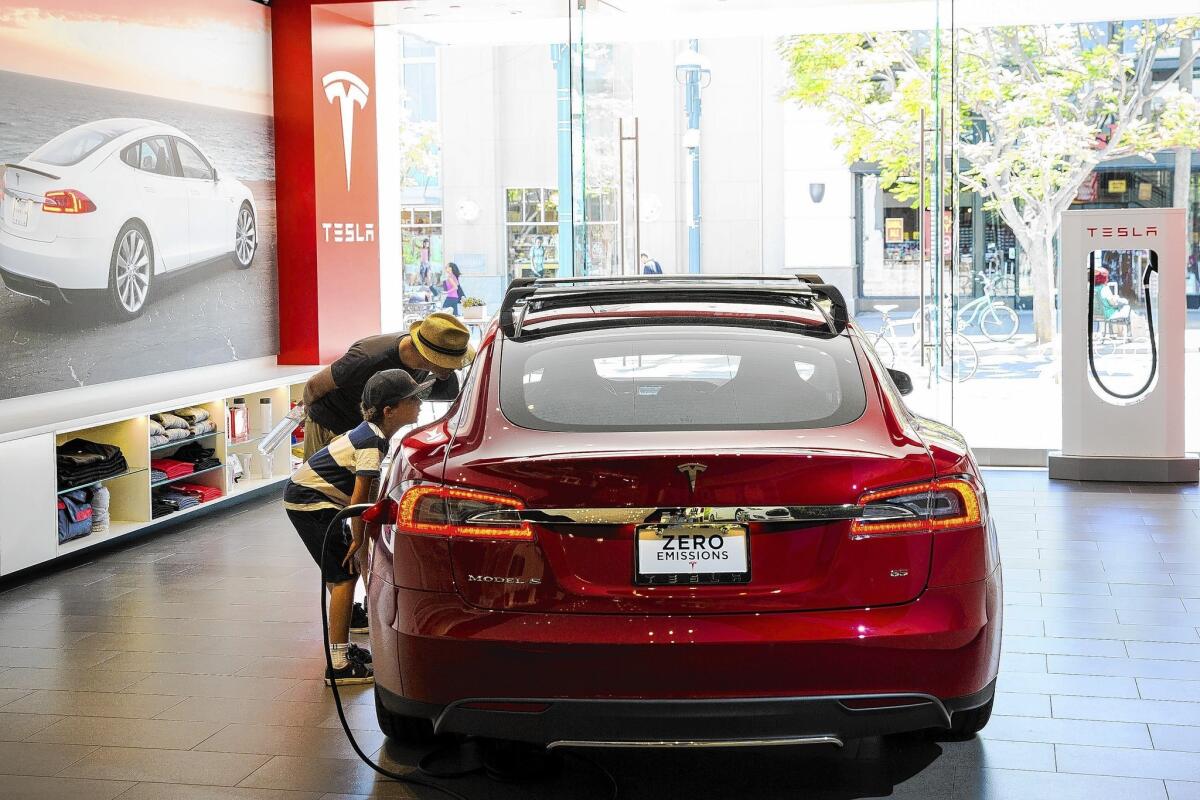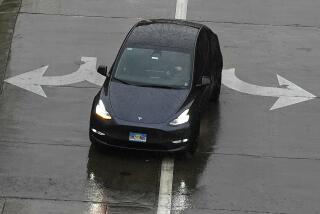Bill would cap income eligibility for state’s clean-vehicle rebates

California wants 1.5 million zero-emission vehicles on the road by 2025 — more than 15 times the number now.
So the state pays buyers $2,500 per car, on top of a $7,500 federal tax credit, to help speed development and promote widespread adoption.
The effort has had mixed results. Sales of electric cars are up but remain well off the pace needed to meet state goals. And the generous subsidies are going largely to some of the state’s wealthiest residents.
Nearly four-fifths of the state rebates went to households earning $100,000 or more, according to a state survey of buyers. Nearly half of those getting rebates for Tesla’s premium electric sedan earned at least $300,000.
With the state’s incentive program constantly running out of funds — about 13,500 buyers are on a waiting list to get their rebate — state lawmakers are now looking to get more of that money into the hands of lower-income drivers.
“A $2,500 rebate to purchase an electric vehicle is not likely to matter to someone earning over $300,000 a year, but it does make a big difference to someone earning $60k a year,” said Sen. Kevin de León (D-Los Angeles). “Every community deserves clean air, regardless of wealth.”
Proposed legislation he wrote underscores the dilemma the state faces in lowering tailpipe emissions in a traffic-choked state: how to nurture the development of expensive automotive technology without simply underwriting high-priced cars for the rich.
Senate Bill 1275 would require the state Air Resources Board to cap the income of those eligible for the rebate and other incentives. Limiting eligibility would stretch out the rebate funds, De León said.
The legislation has support from environmental groups that have been among the biggest advocates of zero-emission vehicles. The bill has passed the Senate and will next be considered by the Assembly’s appropriations committee. It has until Aug. 31 to gain final passage and move to Gov. Jerry Brown’s desk.
The measure is part of a wider effort to sell mainstream consumers on electric and fuel-cell vehicles — and to help automakers overcome their biggest drawbacks, chiefly limited driving range and high cost.
Only Tesla’s Model S has a range that comes close to a tank of gas in a conventional car. Electric cars also take hours to recharge.
Battery-electric cars make up a little more than 1% of new vehicle purchases in California, according to research firm IHS Automotive. Most are Tesla sedans and lower-priced Nissan Leaf compact cars. The Tesla has a driving range of 208 to 265 miles depending on the model, and the Leaf, 84 miles.
Plug-in hybrids — which run on battery power for shorter ranges before a gas engine takes over — are also included in California’s zero-emission vehicle sales goals. They currently account for nearly 2% of new car sales in the state.
Their tiny market share is why state environmental officials offer buyers perks. In addition to the $2,500 rebate for electric cars, buyers get solo-driver access to carpool lanes. Buyers of fuel-cell vehicles and plug-in hybrids are eligible for state rebates of $5,000 and $1,500, respectively.
The federal government offers an additional $7,500 tax credit to buyers of electric cars. But that subsidy favors wealthier buyers in a different way: Buyers must have at least $7,500 in tax liability to take full advantage of the credit.
If passed, De León’s bill would provide other incentives for low-income earners to migrate to electric cars and plug-in hybrids.
A family of four with an annual household income of $53,000, for example, could bundle state incentives toward the purchase of a cleaner vehicle. They could get $1,500 for retiring a high-polluting vehicle, along with the existing $2,500 rebate for buying an electric car.
The family would also qualify for an additional $3,000 incentive for a clean air vehicle, specifically for low-income buyers. The incentive could be even larger for a buyer who lives in a neighborhood with poor air quality.
Alternately, residents could simply retire an older car, without buying a new one, and get $3,000 to pay for a public transit pass or car-sharing program membership.
The Air Resources Board has not taken a position on the legislation. But Erik White, the ARB official who oversees the development of the board’s incentive programs, said rebates are a critical tool to spur sales of new technology vehicles and to meet the agency’s target that 15% of all new car sales in the state will be zero-emission vehicles by 2025.
He challenges the assertion that Tesla’s electric cars are only for rich people.
“I would not consider them luxury cars,” White said. “They are advanced-technology vehicles.”
Tesla’s Model S starts at about $71,000 — for a car with a smaller battery and less driving range — and climbs past $100,000 with options and features. The automaker identifies its main competition as the flagship sedans from Mercedes and Audi.
Nissan’s Leaf sells for $30,000 to $36,000 — in the range of other low-volume, battery-powered offerings from automakers such as Honda, Fiat, Ford and Chevrolet. But those cars are generally comparable to a gas-powered economy car that might sell for about $20,000.
In addition to government subsidies, automakers have proved willing to lease the lower-priced models at deep discounts, losing money on each transaction. Otherwise, many of the cars might not sell at all.
The California bill directs the Air Resources Board to determine income limits for rebates. The board should shoot for a limit that “keeps the program in the black but doesn’t slow progress” toward the state’s clean vehicle goal, said Maxwell Baumhefner, attorney in the clean vehicles and fuels office of the Natural Resources Defense Council.
“You could save quite a bit of money in the program’s budget without having an adverse impact on sales by limiting the upper income folks,” Baumhefner said. “That is a better way to stretch valuable dollars than doing across-the-board rebate reductions.”
It’s unclear whether more affluent buyers will continue buying expensive zero-emission vehicles if they are barred from the subsidies. In the state’s rebate survey, about 72% of all respondents said the state money was “extremely” or “very” important to their purchase decision.
That percentage declined, however, as income rose. About 86% of Nissan Leaf buyers ranked the rebate as “extremely” or “very” important. That fell to 48% of buyers of the Tesla Model S, a premium electric sport sedan.
The big sellers of electric cars in California have not taken a position on the bill.
“I think there is a fair argument that wealthy people have less of a need for rebates than others,” said Diarmuid O’Connell, vice president for business development at Tesla Motors.
But O’Connell added that the rebate has encouraged many Tesla buyers to buy the car, and that’s helped the Palo Alto electric car company reach the point where it is now planning a smaller Model 3 sedan, expected to launch in three years and start at about $40,000.
Tesla faces a unique challenge as a start-up using cutting-edge technology to take on century-old manufacturers, he said.
“If we could have produced a low-priced EV out of the box, we would have,” he said. “We didn’t have the capital; we didn’t have the scale.”
Creating an income test for the rebate might attract a wider range of buyers to electric cars, O’Connell said. But what’s really needed is more public money for subsidies for all buyers, he said.
Nissan also took a neutral stance.
The rebate program has been plagued by funding issues.
The Clean Vehicle Rebate Project ran out of money April 1, forcing the Air Resources Board to establish a waiting list. It has $30 million to pay the rebates, which was authorized as a part of the state budget, but that is yet to be transferred to the Center for Sustainable Energy, which makes the payments.
That’s expected to happen next month, said Colin Santulli, who runs the rebate program. The program looks to be better capitalized for the state’s 2014-15 fiscal year. The Air Resources Board has approved a combined $121 million for the rebates. In all, California has paid out about $147 million through about 70,000 clean vehicle rebates.
De León, the California bill’s author, said the state needs to move more aggressively to zero-emission vehicles in the hands of lower-income drivers.
“We need to invest in efforts to help make electric vehicles more accessible to residents in East Los Angeles, Fresno, Pomona,” he said, “and not just to the people of Beverly Hills and Malibu.”
Twitter: latimesjerry







